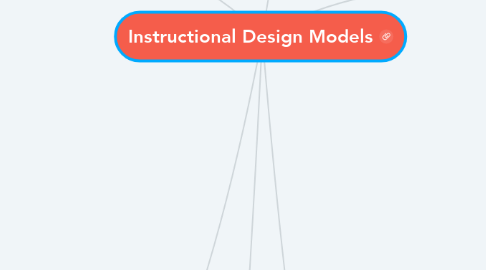
1. Both models emphasize collaboration, efficiency and repetition.
2. ADDIE Model
2.1. The most commonly used instructional design model
2.2. The 5 steps
2.2.1. Analysis
2.2.1.1. Training needs
2.2.1.2. Target audience
2.2.1.3. Learning objectives
2.2.1.4. Resources and Constraints
2.2.1.4.1. Budget
2.2.1.4.2. Deadline
2.2.1.4.3. Ressources available
2.2.2. Design
2.2.2.1. Content sequenced
2.2.2.2. Storyboards
2.2.2.3. Rough drafts
2.2.2.4. Deliverables prototyped
2.2.3. Development
2.2.3.1. Create, assemble, organize digital and print deliverables
2.2.3.2. Videos recorded, edited and produced
2.2.4. Implementation
2.2.4.1. Training accessed and delivered
2.2.5. Evaluation
2.2.5.1. Formative
2.2.5.1.1. Assessment in each stage of the ADDIE process
2.2.5.2. Summative
2.2.5.2.1. Final assessment of the learning process
2.3. Advantages
2.3.1. Step-by-step process
2.3.2. Can be used for any kind of learning
2.4. Drawbacks
2.4.1. Waterfall approach
2.4.2. Time-consuming model
2.4.3. Cost of changes
3. SAM
3.1. SAM: Successive Approximation Model
3.1.1. A popular alternative to ADDIE based on the AGILE approach
3.2. 2 processes
3.2.1. SAM 1: the basic SAM process
3.2.1.1. 3 iterative instructional design steps
3.2.1.1.1. Analyze
3.2.1.1.2. Design
3.2.1.1.3. Development
3.2.2. SAM 2: adapted to complex project
3.2.2.1. 8 iterative instructional design steps
3.2.2.1.1. Preparation (background)
3.2.2.1.2. Iterative Design
3.2.2.1.3. Iterative Development
3.3. Advantages
3.3.1. Iterative approach
3.3.1.1. More cyclical process
3.3.1.2. Continually analyze and evaluate throughout the process
3.3.1.3. Limit any risk of moving out of budget or time if changes occured
3.4. Drawbacks
3.4.1. Require an environment which encourage rapid feedback or flexible processes
4. ADDIE vs. SAM
4.1. WHAT
4.1.1. ADDIE is an established instructional design process applied to all forms of Learning and Development.
4.1.2. SAM is an Agile Instructional System Design model introduced as an alternative to ADDIE.
4.2. HOW
4.2.1. Each step to the ADDIE process needs to be done in sequence, often with the review stage gates in between.
4.2.2. SAM relies on design and development happening in parallel.
4.3. WHO IS FOR
4.3.1. ADDIE is well suited for corporate industries where learning is not a primary business goal.
4.3.2. SAM is often used within learning organizations (e-learning), and is about to enter the corporate sector.
5. Within organizations, SAM requires mindset change to embrace prototyping and creative freedom. This is why SAM can be challenging (but not impossible) within compliance industries.
6. SAM is much more efficient compared to ADDIE in terms of meeting budgets and expectations of learning event development teams.
7. Which ID Model?
7.1. Criterias
7.1.1. The size of the project
7.1.2. Your experience as an Instructional Designer (and the experience of your team!)
7.1.3. The context
7.1.3.1. Client requirements and needs
7.1.3.2. The objectives of the project
7.1.3.3. Opportunity to get rapid feedback or flexible processes?
8. Others ID Models
8.1. ASSURE
8.1.1. Based on ADDIE ID Model
8.1.1.1. Differences
8.1.1.1.1. Focus on the integration of technology (media and materials) and learners participation
8.1.1.1.2. Evaluation is only done at the end of the project
8.1.1.2. Similarities
8.1.1.2.1. Waterfall approach
8.1.1.2.2. Stages are very closed
8.1.2. 6 steps
8.1.2.1. Analyze learners
8.1.2.2. State Objectives
8.1.2.3. Select media and materials
8.1.2.4. Utilize media and materials
8.1.2.5. Require learners participation
8.1.2.6. Evaluate and revise
8.2. Dick And Carey
8.2.1. Focus on relationships between educational content, context, learning behavior, and instructional technique
8.2.2. The 9 steps
8.2.2.1. Identify Instructional Goals
8.2.2.2. Conduct Instructional Analysis
8.2.2.3. Analyze Learners and Contexts
8.2.2.4. Write Performance Objectives
8.2.2.5. Develop Assessment Instruments
8.2.2.6. Develop Instructional Strategy
8.2.2.7. Develop and Select Instructional Materials
8.2.2.8. Design and Conduct Formative Evaluation of Instruction
8.2.2.9. Design and Conduct Summative Evaluation
8.2.2.10. Revise Instruction
8.3. ARCS
8.3.1. Focus on the motivational aspects of learning environment
8.3.2. The 4 steps
8.3.2.1. Attention
8.3.2.2. Relevance
8.3.2.3. Confidence
8.3.2.4. Satisfaction
8.4. Backward Design
8.4.1. learning experiences should be planned with the final assessment in mind.
8.4.2. 3 steps
8.4.2.1. Identify Desired Results
8.4.2.2. Determine Acceptable Evidence of Learning
8.4.2.3. Design Learning Experiences & Instruction
9. What is an ID Model?
9.1. The practice of creating instructional experiences to help facilitate learning most effectively
9.1.1. An ID model provides guidelines to organize appropriate pedagogical scenarios to achieve instructional goals
9.1.2. ID models describe how to conduct the various steps
